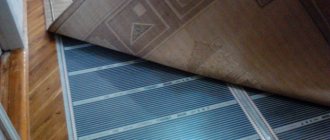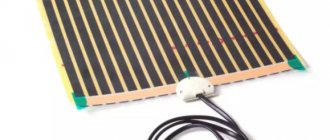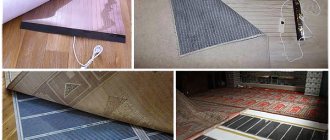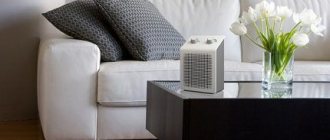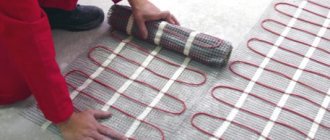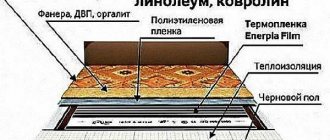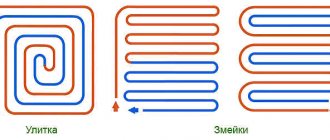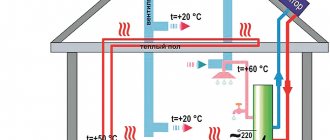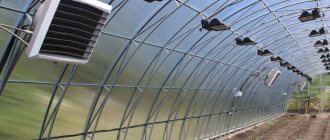Warm floors are no longer uncommon today; they create a more comfortable environment in the apartment. The main thing is to choose the right flooring for such a system. It must be durable and have low thermal insulation.
The purpose of the room also plays an important role, for example, ceramic tiles are suitable for the bathroom, laminate for the living room.
But in the nursery they usually lay a carpet, since children often play on the floor; when installing heated floors, it can be replaced with carpet.
Combination of different types of warm floors and carpet - pros and cons
Carpet is a good thermal insulator, so it is considered that it is not suitable for heating devices, since the heat will be wasted. This is true if you lay thick carpet.
However, today tufted carpet is produced; it is thinner than the standard type, and its properties are similar to laminate or linoleum. Therefore, it is important to choose the right model of carpet (carpet) for a warm floor.
In addition, to reduce heat loss, it is necessary to lay an additional heat insulator in the form of a foil film under the heating elements.
It should be noted that to obtain a temperature on the carpet that is similar in feel to floor tiles, you will need to set the thermostat to 3 to 5 degrees higher.
But it’s worth it, since this floor covering for heated floors has a number of advantages:
- walking on warm, soft carpet is much more pleasant and comfortable;
- it will provide comfortable conditions both when the system is on and off;
- creates excellent sound insulation;
- easy to style;
- has a huge number of models, different colors and pile lengths.
It is impossible not to note the presence of shortcomings:
- Carpet is suitable for rooms where it is dry and clean;
- Requires constant cleaning;
- May cause allergies in susceptible people;
- Such coverage is not appropriate if animals live in the house;
- An excellent thermal insulator is the main disadvantage, but this can be solved if you use the right type of carpet.
Operating principle of the nanomat
Electric portable infrared heated floors are made on the basis of a special polyester film.
Carbon strips and silver-copper conductors, firmly laminated to the base, are used as heating elements. After connecting to the power supply, the carbon atoms in the “filling” are excited. This causes uniform emission of infrared waves with a length of 5 to 20 microns over the entire surface of the film module. A warm floor under a carpet consumes a very small amount of electricity from a standard network during operation. As an example, we can give the following figures: for a module measuring 50 by 35 cm, only 30 W are required. Since the surface heats up to 50 degrees, the use of small modules is possible without additional thermostats. To use a surface with an area larger than a square meter, you need a device to automatically turn off and turn on the device depending on the temperature.
Types of heated floors covered with carpet
Warm floors under laminate, linoleum, carpet, etc.
Currently, there are a wide variety of heating systems for carpeted floors, which are combined with carpet in different ways. Let's look at each type in detail.
Water heated floor
A water floor is a structure made of pipes through which warm water moves. Heating is provided by power supply or heating system. Pipes can be made of: metal, polypropylene, copper, cross-linked polyethylene. You should not skimp on the choice of material; any problems will inevitably lead to the dismantling of the entire cake, including the finishing coating.
This design is more suitable for private houses equipped with autonomous heating.
In addition, this is an excellent solution for rooms whose walls face the street; increasing the number of turns around them will help avoid drafts. In multi-storey buildings with central heating, this model is not recommended.
| Advantages of a water floor | Minuses |
| The heating process occurs slowly, this is important for carpets; with a sharp change in temperature, deformation is possible. | Installing a water system is labor-intensive work. |
| The carpet does not fade, since water moves through the pipes, so there are no overheating spots on the coating. | The height of the floor rises by 10 - 15 cm due to the concrete screed. |
The design of a water heated floor under a carpet is: a concrete sub-base, a layer of waterproofing and insulation, a MAK mesh, a pipeline, a concrete screed and carpet.
Electric heated floor
In an electric heated floor, instead of pipes, there is a heating cable through which electricity passes. Fiberglass mesh or mounting tape is used for fixation. Installation of this system is possible in any room, and installation is easy to do yourself.
The cable system is ideal for houses with ceilings, where heavy loads are contraindicated.
| pros | Minuses |
| Provides uniform heating, which will not lead to deformation of the coating. | A rapid heating process can lead to overheating of the carpet structure, causing it to quickly fail. |
| It is possible to adjust the temperature, which is very important, since the carpet cannot be heated by more than 30 degrees. The presence of an option that allows you to set a limit temperature that will be maintained automatically. | The formation of overheating zones in places of contact with furniture, which will cause fading of the coating and damage to the cable. |
| Simplicity and low cost of installation. | Significant electricity costs. |
| Installation without a concrete screed is allowed; instead, an adhesive composition for slabs can be used. |
Despite all its positive aspects, this type of heated floor cannot be called ideal for carpeting. Because if one section of the cable is damaged, the entire system stops working.
The cake of an electric floor under a carpet looks like this:
- concrete base;
- waterproofing gasket;
- insulation;
- coolant;
- concrete screed;
- carpet
Infrared heated floor
Infrared design is a type of electric flooring. This is a double-sided roll film with built-in heating elements (graphite strips). The tape model is effective in operation, but only dry installation is possible.
When connected to power, the strips heat up and emit infrared warm rays that warm the flooring. This is the best option for carpeting - carpet .
| pros | Minuses |
| Heating is uniform, which eliminates deformation. | The main and main disadvantage of this model is its high cost. |
| Infrared rays act sparingly, which does not lead to carpet fading. | |
| The presence of a thermostat allows you to control the temperature. | |
| Very easy to install and operate. | |
| Minimum energy costs. | |
| If one of the IR strips fails, the entire system will continue to function. | |
| Fireproof | |
| No need for screed |
Infrared film heated floor
Film heated floors are an excellent alternative if it is not possible to install a permanent (stationary) heating system. This is a mobile device; it can be moved from room to room, or placed in a separate area that needs to be heated.
More often, such warm floors are located under carpets, and are laid directly on laminate floors, linoleum, or tiles. Connect to power using the cord included in the kit.
Carpet, as a covering for a heated film floor, is an excellent choice, since its main characteristics are:
- mobility;
- the presence of an option that allows you to control the temperature;
- no damage to the coating;
- power consumption costs are not high;
- ability to choose the device of the desired size.
The ease of installation of this system under the carpet is also of no small importance, since there is no need to level the surface and carry out work on installing the device. In addition, it will be inexpensive.
Free way.
This method of flooring is considered the most economical, as it is carried out using improvised means. It has two varieties, distinguished by the method of fixation:
- Along the perimeter. This mounting option is the simplest, because the carpet is attached using a plinth. To begin with, the material is spread around the entire perimeter of the room. A prerequisite is an allowance on each side, which should be about 15 cm. The carpet is leveled from the center to the edges. This process can be carried out either with a special roller or by hand. Only after careful smoothing is the excess material cut off, and the remaining carpet is secured with skirting boards around the perimeter. In the doorway it is most often secured with a metal strip or threshold.
The advantages of this installation:
- The material can be easily dismantled if necessary and re-attached.
- The entire flooring process does not require the help of professionals, which saves a lot of money.
- No additional equipment or materials are required for fastening.
- It is not necessary to prepare the floor before starting work.
- After a long period of use, wrinkles or bubbles may form on the surface.
- This fixation method is not suitable if the room has mobile furniture equipped with roller wheels.
- Rearranging furniture may be more problematic as the covering may move.
- Careful care of the carpet will be required, since the use of washing vacuum cleaners is not recommended.
- The material should be monolithic, and the room should not be too large.
Making a choice
To avoid any unpleasant surprises during the operation of a heated floor with carpet, you need to take a serious approach to choosing a system.
You should take into account:
- type of premises (private building or apartment);
- location of walls;
- carpet thickness;
- furniture arrangement;
- financial opportunities.
Only after analyzing these indicators can you correctly decide on the choice of system and installation method.
Based on all of the above, we can conclude:
- Infrared heated floors under carpet are the most optimal solution. It is gentle on the flooring and has a thermostat to control the temperature. The absence of a concrete screed in the floor pie is also of great importance, and this is especially important with a high degree of thermal conductivity of the carpet.
- Mobile device - suitable for temporary housing or summer cottage. Easy to carry and install.
- A water floor is an excellent choice for private houses with autonomous heating, even despite the labor-intensive work. Treats carpet with care.
- Electric flooring is less suitable for installation under carpet. It produces strong heating, which damages the carpet.
It is worth considering who will install the system. Let’s say you can lay an infrared heated floor with your own hands, but if you decide to make a water structure, it is better to invite professionals.
Mobile mat - palace
The warm floor under the Teplolux carpet is a structure somewhat different from the film structure.
Its surface is made of artificial felt, which is durable and easy to clean. The canvas has certain dimensions and is available in two modifications: 2 by 1.5 m and 2.8 by 1.8 m. The basis of its heating filling is a thin cable in a protective hermetic sheath. The mat is connected to the power supply via a 2.5 meter installation wire. Such a mobile heated covering can be placed under woven, lint-free or pile carpets of medium thickness, the surface of which will be evenly heated to 35 degrees. The infrared heated floor under the carpet is connected to the electrical network using a universal plug suitable for any type of socket. The wire is fixed through the power box. The optimal temperature regime is maintained by a functional and convenient power regulator.
Installation of infrared heated floor under carpet
Warm floor CALEO (Kaleo) - video instructions for installation under linoleum and carpet
Infrared heated floors, as mentioned above, are one of the most suitable options for installation under carpet. In addition, you can install this system yourself. The covering is assembled from separate elements.
Step-by-step installation of an infrared structure under a carpet looks like this:
- preparation of the base - by repairing the existing concrete screed or installing plywood flooring;
- laying foil insulation;
- placement of film elements according to the manufacturer’s instructions;
- connecting and checking the system;
- pouring a very thin concrete screed or applying an adhesive composition;
- laying out the carpet.
At this point, work on installing the heated structure under the carpet is completed. And you get a warm and soft floor.
What is the difficulty?
Carpet is a common floor covering, but when used in a heated floor system, a number of issues arise because it is a good thermal insulator. There are concerns that heat will accumulate under the covering, not heating the room to the required extent.
Infrared film heated floor
Experts recommend choosing the type of material wisely, and also providing an insulating layer with a heat-reflecting surface during installation. In this case, the heating system will function efficiently. The advantage of long-pile carpet is the fact that it additionally retains heated air, which allows children to play on the floor without fear of catching a cold. There are two types of such material:
- shaggy with the effect of homemade coarse yarn, characterized by abrasion resistance;
- katlup with an interesting texture, creating the effect of a multi-level surface. Step-by-step instructions for laying carpet on a heated floor
Warm floor under carpet on wooden floor
If there is a subfloor made of wood, and it is not permissible to increase the load on it, it is possible to install a heated floor under the carpet in a “dry” manner. It is allowed to install both water and electrical systems.
Pipes or cables are installed on a wooden floor in grooves prepared from slats. The size of the openings must be equal to the thickness of the heating elements. You can install ready-made modules on a wooden floor, into which the heater will be installed.
There is another way - grooves are cut into polystyrene foam, it will simultaneously serve as insulation and prevent heat from escaping through the subfloor. On top, this structure is covered with plywood or chipboard sheets on which the carpet will be laid.
Infrared heated floors can be laid directly on a wooden base, then covered with plywood and carpet.
For your information! To eliminate unexpected heat costs or keep them to a minimum, it is recommended to lay a foil film between the heating elements and the subfloor, which will reflect infrared rays upward.
It is possible to use carpet in combination with warm floors if the requirements for the material are properly met. The structure of the coating must have a porous and natural base. Such a product will not interfere with the passage of heat so much.
However, you will need to regularly clean the carpet to prevent dust mites from infesting it. But this drawback is compensated by the comfort of the floor at any time of the year.
How to assemble an IR mat
The warm floor under the carpet is assembled with your own hands on the free surface of the room. First, steam and thermal insulation materials are laid out. Using ordinary scissors, the infrared film is cut according to the selected dimensions and laid out on top of the insulation. The conductive film strips are connected in parallel, secured together with clips. All contacts must be carefully insulated with mastic glue for rigidity. The film, thermostats and electrical wire are combined into one system and connected to an outlet to test functionality. The final stage is to lay a vapor barrier on top again, then a finishing layer of carpet or just a regular rug. Warm floor under the carpet is ready for use! The top covering over the film material should not be too thick, otherwise all the heat will remain under the carpet.
How can carpet save you money and keep you warm in winter?
With winter approaching and utility costs rising, choosing the right rugs for your home is a great way to stay warm and save money. Floors without proper carpeting and insulation are major sources of heat loss.
How to lay a carpet correctly: preparing the base
While a good carpet is essential to keeping your home warm during the winter, it will be more effective if you take a few other important steps beforehand.
How to lay a carpet correctly: insulate your home
It's never too late to insulate your home—homes without insulation are 70% cooler than homes with insulation, and insulation can cut heating costs by 45-55%.
How to Install Carpet: Shorten the Openings
If you add up all the openings and cracks in the average house together, they are equivalent to leaving a 1 x 1.5 meter window open 24/7! Seal all holes with good quality filler or caulking and you will see a big difference.
System advantages
The installation of water, electric, or any other type of heated floor is not associated with the installation of radiators above its surface.
Heated floors have the following advantages compared to conventional methods of heating rooms:
- Lack of air convection, which in turn eliminates the appearance of drafts.
- Safety . The installation of water, electric, or any other type of heated floor does not involve the installation of radiators above its surface. Therefore, children can in no way be burned by hot equipment.
- It is possible to create local heating zones (children's room, area near the bed, etc.).
- Harmony of design. Heat sources are disguised and do not spoil the appearance of the room.
When is it possible
Small decorative rugs near upholstered furniture are always allowed. Cloths occupying a large area on a heated floor are permissible only if they have high thermal conductivity. And even then, it is better to choose durable mats or openwork fabrics made from natural materials - synthetics will not last long.
As for mobile heated floors, they need a carpet - this is the very protection from mechanical impact. True, you should still not use options that are too dense and fluffy - with such a coating, the efficiency of the heaters is reduced, and their circuitry requires the connection of automatic thermostats. The best option is heat-resistant synthetics or natural fabrics of medium density. Let's say short pile. But it is better to avoid bright colors and patterns - it is unknown whether the dye will withstand the temperature test.
conclusions
In a private house, where there is enough space and technical capabilities to equip a “warm water floors” heating system, you can use carpeting for finishing. It is not recommended to cover all floors in the house with carpet. This will cause your heating boiler to work constantly in increased mode. Making a children's room with carpet, carpeting the living room, using a water floor, the task is real and feasible.
Source
Features of laying roll coverings
After the heated floors have been laid, it’s time to think about installing the floor covering (how to install a water circuit with your own hands is described in the corresponding article).
To lay roll material, you will need to follow the following recommendations step by step:
Which linoleum is better for a water floor?
Choosing linoleum for a water-heated floor can be difficult, since there is a wide variety of products that differ in both purpose and performance characteristics.
You should pay attention to the following criteria:
When choosing a finishing material, you should seek help from a consultant and purchase one that is of high quality and wear resistance.
Which carpet is suitable for a water floor?
When choosing carpet for a heated water floor, you should follow the same instructions as when purchasing suitable linoleum:
Under certain conditions, roll materials can be used as a finishing coating for heated water floors. In this case, you will need to comply with the rules associated with installation and safe subsequent operation.
Source
Security measures
The IR device can be safely placed under the carpet, since such systems have long been recognized as completely safe. Any installation work must be carried out step by step, following the attached instructions. To avoid possible fire and electric shock, take the following precautions:
- Give preference to automation. For such equipment, a separate electrical branch should be used. It will be necessary to install machines that will be located near the meter. An RCD is also required.
- Control block. You will need a thermostat if you plan to use carpet. It will help avoid overheating and reduce energy consumption.
- High-quality grounding. All conductive elements require separate insulation. Conductive tape will be needed to cover the entire perimeter of the film.
Device
A heated floor system is a multi-layer cake that performs several tasks simultaneously:
- cutting off the subfloor from the heater to eliminate wasteful consumption of thermal energy;
- floor heating;
- protection of the heater from mechanical damage (especially important for water pipelines);
- floor covering that directly transfers heat into the atmosphere of the home.
For water floors
For water heated floors, the usual composition of the cake is as follows.
On a concrete subfloor:
- Concrete floor.
- Waterproofing layer.
- Insulation layer (EPS).
- MAK mesh (or a similar mesh to equalize the load on the pipes).
- Water heated floor pipes.
- Concrete screed.
- Carpet.
On a wooden subfloor:
- Heated floor pipes (or, as an option, modules or polystyrene foam with laid heated floor pipes).
- A protective layer of plywood, chipboard or similar rigid sheet materials.
- Carpet.
For electric
Pie composition for electrical systems.
For concrete floors:
- Concrete subfloor.
- Waterproofing, insulation layer.
- Heating cable (mats).
- Screed layer.
- Carpet.
Attention! For electrical cable systems, the layer of screed may be thinner - sometimes only to level the surface, since there is no danger of rupture of pipes under pressure. For wooden floors:
For wooden floors:
- The cable (mats) or film emitter is laid directly on the subfloor.
- A protective layer of sheet materials is laid on top - chipboard, plywood, etc. (this is not necessary for film systems).
- Carpet.
To eliminate wasteful heat consumption, it is recommended to place a layer of foil film between the heater and the subfloor, which reflects infrared rays upward and prevents unnecessary heating of the subfloor.
